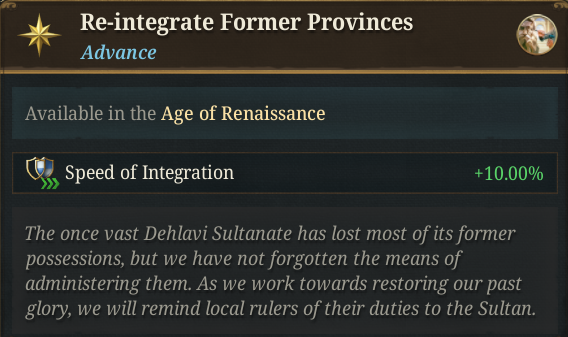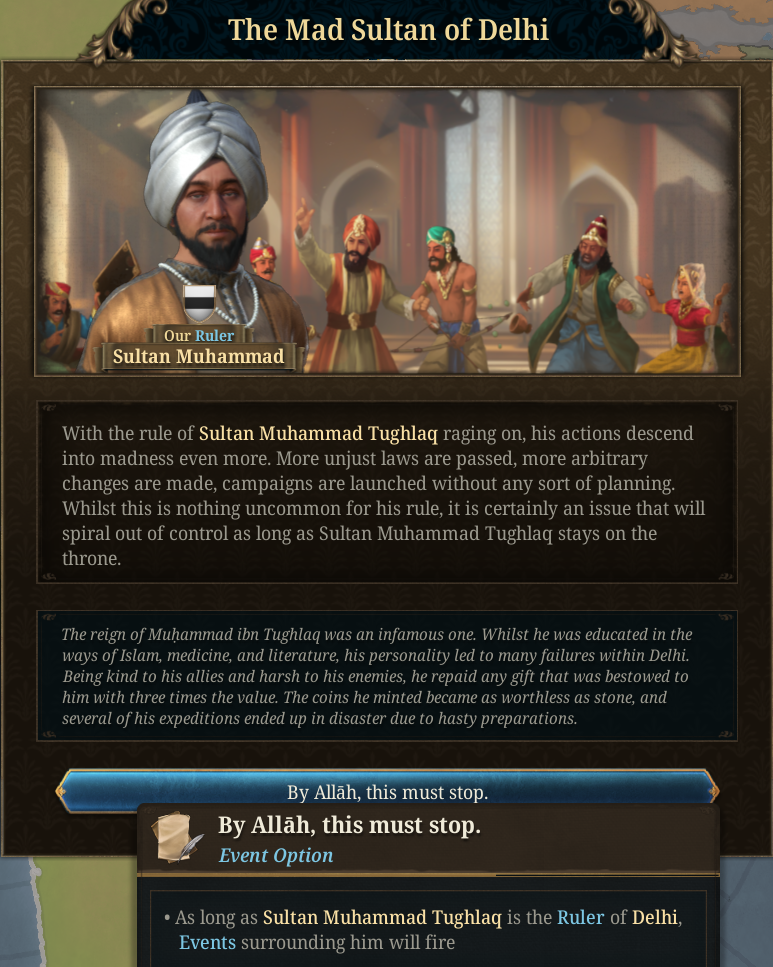Hello, and welcome one more week to Tinto Flavour, the happy Tuesdays & Fridays in which we take a look at the content of Europa Universalis V!
Today, we will be taking a look at the flavour content for the Sultanate of Delhi, the most powerful Indian country in 1337 - but not without a few curveballs to tackle. Let’ start without further ado:

As usual, all UI, 2D and 3D are WIP.



The starting situation of Delhi. There’s a bug with the coloring of subjects of subjects, but Gaur has a subject itself, Taraf.
This is the starting Government setup content for Delhi, and other Indian Muslim Sultanates, as well:







The last one was already shown, but it’s super important for Delhi’s starting setup, as only 2% of its pops are Sunni, the state religion, as shown in the Country Selection screenshot.
Related to this, a tab that we usually don’t show, the Rebels one, as it’s also quite relevant to Delhi’s start:

This is not final, but gives an idea that managing Delhi at the start may not be easy…
Delhi also starts with a Work of Art:

And here are some of its advances:





Delhi’s advances are quite interesting - the country will need those modifiers…
But the most interesting for Delhi is its narrative content, because soon after the game starts, a situation will pop up, ‘The Fall of Delhi’:








So, when the situation is active, several events may trigger, which may influence the ‘Share of Power’ of the situation:


This modifier scales based on how many countries support the Opposing side.
This might end up being the situation some months after it starts, if the player is not careful enough:

The situation may last for years, even decades, creating a very challenging gameplay for Delhi, with even more events popping up:



The end requirements of the situation are the following, with different possibilities:

One of them is a disaster that may trigger to Delhi, making the situation even worst:



While this disaster is active, some historical revolters may appear: the Bahmanis, Malwa, Gujarat, or Jaunpur. The player can choose to either keep playing as Delhi or to start playing with one of them.
Besides that, Delhi has dozens of other non-Situation, non-Disaster related events, such as:




… And much more, but that’s all for today! This will be the schedule for next week:
Today, we will be taking a look at the flavour content for the Sultanate of Delhi, the most powerful Indian country in 1337 - but not without a few curveballs to tackle. Let’ start without further ado:

As usual, all UI, 2D and 3D are WIP.



The starting situation of Delhi. There’s a bug with the coloring of subjects of subjects, but Gaur has a subject itself, Taraf.
This is the starting Government setup content for Delhi, and other Indian Muslim Sultanates, as well:







The last one was already shown, but it’s super important for Delhi’s starting setup, as only 2% of its pops are Sunni, the state religion, as shown in the Country Selection screenshot.
Related to this, a tab that we usually don’t show, the Rebels one, as it’s also quite relevant to Delhi’s start:

This is not final, but gives an idea that managing Delhi at the start may not be easy…
Delhi also starts with a Work of Art:

And here are some of its advances:





Delhi’s advances are quite interesting - the country will need those modifiers…
But the most interesting for Delhi is its narrative content, because soon after the game starts, a situation will pop up, ‘The Fall of Delhi’:








So, when the situation is active, several events may trigger, which may influence the ‘Share of Power’ of the situation:


This modifier scales based on how many countries support the Opposing side.
This might end up being the situation some months after it starts, if the player is not careful enough:

The situation may last for years, even decades, creating a very challenging gameplay for Delhi, with even more events popping up:



The end requirements of the situation are the following, with different possibilities:

One of them is a disaster that may trigger to Delhi, making the situation even worst:



While this disaster is active, some historical revolters may appear: the Bahmanis, Malwa, Gujarat, or Jaunpur. The player can choose to either keep playing as Delhi or to start playing with one of them.
Besides that, Delhi has dozens of other non-Situation, non-Disaster related events, such as:




… And much more, but that’s all for today! This will be the schedule for next week:
- Monday -> Tinto Maps Feedback about India
- Tuesday -> Tinto Flavour about Sweden, hosted by @Johan
- Wednesday -> Tinto Talks about Unit Graphics, hosted by @SaintDaveUK
- Thursday -> Second ‘Behind the Scenes’ video!
- Friday -> Tinto Flavour about Muscovy/Russia




